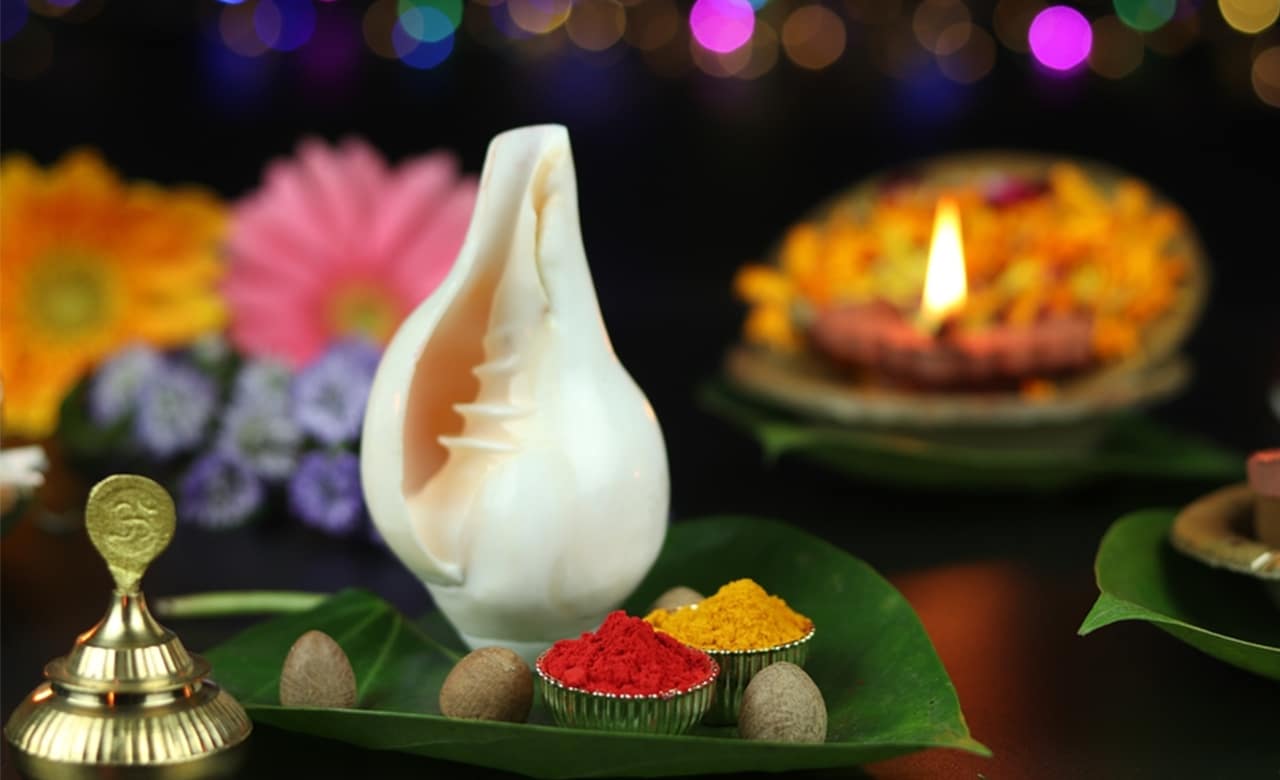
Informative
Shankh, the Celestial Conch
During the prehistoric and medieval eras, it was used as the trumpet of the war. These days, it’s used during the Puja ceremonies to celebrate devotion. It’s considered the sacred emblem of Bhagavan Vishnu, and during the Navratri festival, Divine Mother Durga’s arrival is announced by blowing it.
As you might have guessed, we are talking about the celestial conch, Shankh, which has immense importance in Sanatana dharma. In this blog, we are talking about its Pauranik origins, types, its effect on Vastu, and its significance in spirituality.
Origins of Shankh
During Samudra Manthan, or churning of the celestial sea, 14 gems appeared out of it, and a Shankh named Panchajanya was one of them, along with Divine Mother Lakshmi. So, Shankh is considered the brother of Divine Mother Lakshmi, as both have appeared from the sea.
Shankh is the emblem of lord Vishnu, and every Vigraha of Lord Vishnu is considered incomplete without He holding the conch. Even the Lord of wealth-Kuber has eight most precious jewels in the universe, and one of them is Shankha Nidhi, the conch.
Atharva Veda, the ancient Vedic text, mentions Shankh and describes its celestial sound. Hundreds of Puranas, Shastras, and epics tell how every Gods have their own Shankhs and how they played it during the battles. For example, Lord Krishna has His conch named Panchajanya, and Devadatta was the name of Arjuna’s conch. Yudhishthir had a conch named Anantavijay, Bhim had a conch named Paundra and Nakul had a conch named Sughosh.
What are the different types of Shankh?
Dakshinavarti Shankh: It’s also called the Lakshmi Shankh because it’s considered the abode of Lord Kuber. It has a closed mouth; hence, it’s not used for blowing, but it’s used for the Puja. They are considered auspicious and bringer of good luck and prosperity.
It’s kept in the prayer room and decorated with Swastika, drawn on it with the Kumkum. During the Puja, it was worshipped with Diya, sandalwood, and flowers.
Vamavarti Shankh: It opens on the left hand and has a wide mouth opening. It’s used for blowing during the prayers. It should be held with the left hand while blowing. Sounding the Vamavarti Shankh repels the negativities and purifies the surroundings.
Ganesh Shankh: It’s the conch with a curvy tail, like the trunk of Lord Ganesh. It does not have a mouth for blowing, and it’s kept in the prayer room near the Gods. Praying to this Shank is considered auspicious and removes obstacles from your path. If it’s kept in the Puja room, it should be worshipped daily, and if you want to keep it in the house for Vastu reason, it could be kept inside the locker, wrapped in red cloth for prosperity.
Panchmukhi Shankh: Also known as the Gaumukhi Shankh, this conch is usually kept in the temples. Praying to the Gaumukhi Shankh, consecrated and kept in the temple, yields the same blessings as keeping the cow at home. Just like a cow is considered a symbol of abundance, the Panchmukhi conch also blesses you with happiness, good luck, and prosperity.
Kauri Shankh: Kauris are nature’s smallest and most abundantly available Shankhs. Kauri Shankh has been believed to attract prosperity and wealth for thousands of years. During prehistoric times it’s been used as a currency and part of the bride’s attire during prehistoric times. As per Sanatana Shastra, Divine Mother’s blessings reside on the Kauri and are usually kept in a cash box for prosperity, wealth, and abundance.
Moti Shankh: Moti means pearl. It’s as shiny and lustrous as a natural pearl. It’s considered one of the rarest and most expensive conchs in the world. It’s kept in the house to attract fortune, prosperity, luck, and success. It’s known to enhance the power of the moon in your life, bringing softness, charm, family life, and love to your life.
Gomati Shankh: Also known as the Gomati Chakra, it’s a form of shell stone or a fossilised conch. It’s considered very auspicious, as it resembles the shape of Krishna’s Sudharshan chakra. It’s often used as a Yantra to meditate and pray. As per Vastu experts, burying the Gomati conch in the foundations removes all sorts of Vastu Doshas from the new house. During the auspicious time of Diwali, it is worshipped along with the Divine Mother Lakshmi.
Spiritual Benefits of Shankh:
-Shankh brings peace and prosperity to the home.
-Regular blowing of the Shankh repels the negative vibrations from the surroundings and attracts positivity.
-When kept in study, it brings knowledge by the blessings of Divine Maa Saraswati.
-In the house with Vastu dosha, blowing the conch reduces the mal effects of the dosha.
-When kept in the bedroom, a conch strengthens the marital bond between a couple and enhances the relationship’s peace of mind and positivity. Dakshinvarti Shankh shields the children from nightmares as well.
-Many Vastu experts recommend burying a Shankh in the foundations of the building to shield the building from Vastu dosha.
-Keeping Dakshinavarti Shankh in the locker brings prosperity to the business, and keeping it in the kitchen prevents scarcity of the foods.
-When the water filled in Shankh is sprinkled around the house, it removes the negative vibrations from the house’s dark corners. Even it shields the home from any hexes or evil eyes.
-Conch is one of the eight signs of Lord Buddha, symbolising healthy communication, relationship, and prosperity. In Feng Shui, a water fountain designed with a conch symbolises an influx of money coming to the house.
– Blowing shakha keeps the lungs healthy. As we blow up the Shankh, it empties the lungs entirely and fills lungs with fresh air. This exercise makes the lung muscles stronger. Regular blowing the Shankh even cures a few intestinal diseases as well.
-According to the ancient scriptures of Purana, blowing Shankh activates the Sushumna channel of the body.
Keeping Shankh at home:
Before keeping the Shankh at home, one should consult their Guru or spiritual experts regarding which Shankh should be best suited for them. As per the scriptures, a conch shell must be established in the home or in the temple on an auspicious day, like Diwali, Navratri or Mahashivaratri, etc. During the consecration, Shankh should be washed with Ganga Jal.
It is believed that the energy from the gods enters through the pointy beak and spreads from the mouth of the Shankh. Hence, if you keep the Shankh in the shrine, ensure its pointy end points towards the gods, with the open part upwards.
Vastu even suggests that the Shankh should be kept on the right side of the prayer room. During Puja, Shankh should be washed, cleaned, and wiped out with a clean cloth regularly. Blowing Shankh should not be used to wash deities and should never be kept lying on the floor, as it’s considered the abode of Divine Mother Lakshmi.
Shankhini: If you find Shankh on the beach, first take it to the spiritual expert before putting it into your home. Many times, Shankhini is also mistaken for Shankh. Shankhini is a female form of Shankh, a kind of shell stone with a rough surface. Shankhini is known to attract negative energies; hence, it should be kept away from the prayer rooms at any cost. Only the Aghori sect uses these Shankhini to attract negative energies for their spiritual practices.
We hope you have gained some new insight into the importance of a Shankh in Sanatana Dharma. Next time, when you apply it to your forehead, remember what it symbolises, and what it can do to your spirituality.
Please subscribe to our mailing list to stay connected and receive information about spirituality. In case of any queries, please write to us at info@chamundaswamiji.com. You can check out our YouTube channel Chamunda Swamiji where you can learn Tantra, Mantra, Yantra, and Meditation from His Holiness Shri Chamunda Swamiji.
Post a Comment
-
Subscribe to Our Blog
-
Categories
-
Popular Articles
- Dead moth in the house. What universe is trying to tell you?
- Spiritual Meaning of Moth
- Vivah Bandhan Curse – What Is It and How to Spiritually Heal It.
- The Dasa Mahavidyas
- What are Beej Mantras?
- Tripura Sundari | The Dasa Mahavidya
- Maa Bhuvaneshwari | The Dasa Mahavidyas
- The Five Shades of Tantra
- Ramakrishna Paramhansa – The Man who almost became a Woman
- Maa Chinnamasta | The Dasa Mahavidyas



